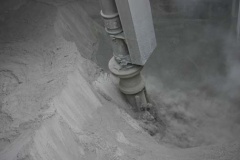Difference between revisions of "Cement"
| Line 1: | Line 1: | ||
{{Infobox_Minerals | {{Infobox_Minerals | ||
| − | | image = | + | | image = Cement-1.jpg |
| origin = - | | origin = - | ||
| stowage factor = - | | stowage factor = - | ||
Revision as of 15:26, 7 January 2013
| Infobox on Cement | |
|---|---|
| Example of Cement |  |
| Facts | |
| Origin | - |
| Stowage factor (in m3/t) | - |
| Humidity / moisture | - |
| Ventilation | - |
| Risk factors | - |
Cement
Contents
Description
Cement is a grey dusty cargo.
In the most general sense of the word, a cement is a binder, a substance that sets and hardens independently, and can bind other materials together.
Cement used in construction is characterized as hydraulic or non-hydraulic. Hydraulic cements (e.g., Portland cement) harden because of hydration chemical reactions that occur independently of the mixture's water content; they can harden even underwater or when constantly exposed to wet weather. The chemical reaction that results when the anhydrous cement powder is mixed with water produces hydrates that are not water-soluble. Non-hydraulic cements (e.g., lime and gypsum plaster) must be kept dry in order to retain their strength.
The most important use of cement is the production of mortar and concrete—the bonding of natural or artificial aggregates to form a strong building material that is durable in the face of normal environmental effects.
Cement is made by heating limestone (calcium carbonate) with small quantities of other materials (such as clay) to 1450 °C in a kiln, in a process known as calcination, whereby a molecule of carbon dioxide is liberated from the calcium carbonate to form calcium oxide, or quicklime, which is then blended with the other materials that have been included in the mix. The resulting hard substance, called 'clinker', is then ground with a small amount of gypsum into a powder to make 'Ordinary Portland Cement', the most commonly used type of cement (often referred to as OPC).
Portland cement is a basic ingredient of concrete, mortar and most non-specialty grout. The most common use for Portland cement is in the production of concrete. Concrete is a composite material consisting of aggregate (gravel and sand), cement, and water. As a construction material, concrete can be cast in almost any shape desired, and once hardened, can become a structural (load bearing) element. Portland cement may be grey or white.
Concrete should not be confused with cement because the term cement refers to the material used to bind the aggregate materials of concrete. Concrete is a combination of a cement and aggregate.
Cement sets or cures when mixed with water which causes a series of hydration chemical reactions. The constituents slowly hydrate and crystallize; the interlocking of the crystals gives cement its strength. Maintaining a high moisture content in cement during curing increases both the speed of curing, and its final strength. Gypsum is often added to Portland cement to prevent early hardening or "flash setting", allowing a longer working time. The time it takes for cement to cure varies depending on the mixture and environmental conditions; initial hardening can occur in as little as twenty minutes, while full cure can take over a month. Cement typically cures to the extent that it can be put into service within 24 hours to a week.











